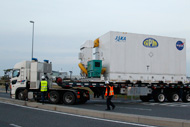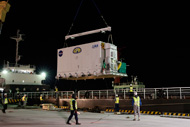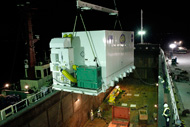Columnコラム
2013
11.25
JAXAとNASAが共同開発の人工衛星「GPM主衛星」、日本に到着!
JAXAとNASAが共同開発の人工衛星 GPM主衛星が11月24日(日)12時28分頃にNASAゴダード飛行センターから北九州空港に到着し、貨物船により打上げ場所となる種子島宇宙センターに向かいました。
北九州空港の到着は22日を予定していましたが、給油地のアラスカの悪天候の影響で2日遅れでの到着になりました。
GPM計画はGPM主衛星と8機程度の衛星群(コンステレーション)を組み合わせて、地球全体の雨の様子を高精度・高頻度で観測する国際協力ミッションです。今回、日本に到着したGPM主衛星が打ち上げられることでGPM計画が本格始動し、全地球規模での水資源管理や台風・洪水等の水災害の被害低減、天気予報の精度向上等、私たちの日常生活のあらゆる場面で役立てられます。
また、GPM主衛星に搭載される二周波降水レーダ「DPR」は、雨を三次元で精度よく観測することができる日本が開発した最先端の観測装置です。
GPM主衛星が日本に到着したことについてJAXAの小嶋正弘プロジェクトマネージャは「悪天候の影響で到着が遅れて心配しましたが、本日無事に到着してホッとしています。これからの射場作業をしっかりやって予定通りのロケット打上げに向けて頑張っていきたい。」とコメントしています。また、NASAのArt Azarbarzin(アート・アザバージン)プロジェクトマネージャは「こちらに到着でき、わくわくしております。給油などのためアンカレッジに立ち寄り、長旅となりました。こちらに到着し、種子島で私どもの作業を継続できますことを大変嬉しく思いますと共に、打上成功を楽しみにしております。」と打上げへの期待を新たにしています。
いよいよGPM主衛星はH-ⅡAロケットでの打上げに向けて最終段階に入りました!
種子島でのNASAやJAXAによる衛星作業の様子なども発信していきますので、今後もご期待ください!
(広報担当:菅谷)
GPM core observatory jointly developed by JAXA and NASA arrived in Japan!
The core observatory for the Global Precipitation Measurement (GPM) mission arrived at Kitakyushu Airport in Japan from the NASA Goddard Space Flight Center in the U.S.A. about 12:28 p.m. on Nov. 24 (Sun.) The GPM core observatory was jointly developed by JAXA and NASA. After arrival at the airport, the satellite was then transported to the Tanegashima Space Center by cargo ship for launch by the H-IIA Launch Vehicle. Its arrival here was originally scheduled for the 22nd, but it was delayed for two days due to bad weather in Alaska, where the cargo plane stopped for refueling.
The GPM mission is a joint international project to observe global precipitation conditions quite frequently and accurately by combining the core observatory and a consternation of some eight satellites. The GPM mission will begin on a full scale when the core observatory, which came to Japan today, is launched, and it will become useful in many ways for our daily life including global-scale water resource control, damage mitigation for water-related disasters such as typhoons and floods, and weather forecasting accuracy improvement.
The Dual-frequency Precipitation Radar (DPR) aboard the GPM core observatory developed by JAXA is one of the cutting-edge observation devices developed in Japan. It enables three-dimensional observations of rain with high sensitivity.
Upon arrival of the core observatory, JAXA's GPM/DPR Project Manager Masahiro Kojima commented, “I was worried about the late arrival (of the observatory) due to adverse weather, thus I am very relieved to see it is finally here. We are bracing for launch site operations to be ready for the scheduled launch.”
NASA's Project Manager Art Azarbarzin expressed his reaffirmed expectations for the launch, “I'm very excited to be here. We had a long journey, (as we) had to stop in Anchorage for some refueling. I am very excited to be here, and continue our processing at the Tanegashima (Space Center), and look forward to a successful launch.
The GPM core observatory operation is now in the final preparation phase for launch by H-IIA. Please look on our website for our report of the satellite launch-site preparations by NASA and JAXA at the TNSC.
(written by Sugaya,GPM/DPR Public Affirs Officer)








